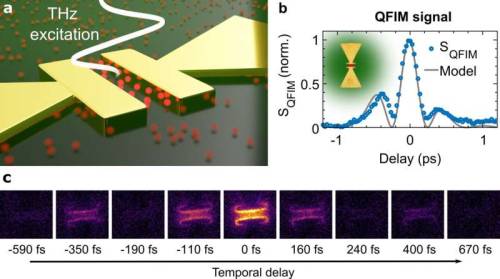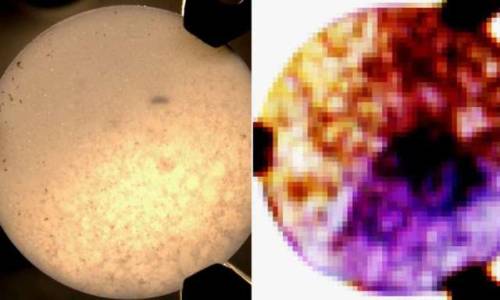#terahertz
Closing the gap: On the road to terahertz electronics
Asymmetric plasmonic antennas deliver femtosecond pulses for fast optoelectronics
A team headed by the TUM physicists Alexander Holleitner and Reinhard Kienberger has succeeded for the first time in generating ultrashort electric pulses on a chip using metal antennas only a few nanometers in size, then running the signals a few millimeters above the surface and reading them in again a controlled manner.
Classical electronics allows frequencies up to around 100 gigahertz. Optoelectronics uses electromagnetic phenomena starting at 10 terahertz. This range in between is referred to as the terahertz gap, since components for signal generation, conversion and detection have been extremely difficult to implement.
The TUM physicists Alexander Holleitner and Reinhard Kienberger succeeded in generating electric pulses in the frequency range up to 10 terahertz using tiny, so-called plasmonic antennas and run them over a chip. Researchers call antennas plasmonic if, because of their shape, they amplify the light intensity at the metal surfaces.
Post link
Ultrafast imaging of terahertz electric waveforms using quantum dots
Microscopic electric fields govern a remarkable variety of phenomena in condensed matter and their ultrafast evolutions drive plasmonics, phononics and highspeed nanoelectronics. Access to high-frequency electric waveforms is of crucial importance to diverse disciplines in nanoscience and technology, yet, microscopic measurements are still severely limited.
In a new paper published in Light: Science & Applications, a team of scientists, led by Prof. Georg Herink from the University of Bayreuth, Germany, and co-workers from the University of Melbourne, Australia, has introduced a new THz microscope for imaging ultrafast electric waveforms encoded in the visible luminescence of nanocrystal probes. Strong electric fields modulate the emission yield of nanocrystals and enable the detection of THz near-field waveforms by microscopy of visible photons in the far-field.
The researchers generated ultrafast electric fields inside gold structures using intense Terahertz pulses. A layer of semiconductor nanocrystals covering the samples is excited by ultrashort visible pulses and shows modulated visible emission depending on the momentary local THz electric field. Fundamentally, this probing of electric fields via luminescence yield is enabled by the quantum-confined Stark effect in quantum dots, generating the contrast mechanism of the scheme termed Quantum-Probe Field Microscopy (QFIM). While scanning the temporal delay between THz excitation and optical pulses, an optical fluorescence microscope captures snapshots of the modulated local emission and generates movies of the local fieldevolution.
Post link
Terahertz imaging technique reveals subsurface insect damage in wood
Insect infestation is becoming an increasingly costly problem to the forestry industry, especially in areas experiencing increased droughts and hot spells related to climate change. A new terahertz imaging technique could help slow the spread of these infestations by detecting insect damage inside wood before it becomes visible on the outside.
“Our approach could be used to detect early-stage insect infestation on the trunks of trees, in imported wood or on wood products in an early infestation stage,” said research team member Kirsti Krügener, from HAWK University of Applied Science and Arts in Germany. “This could help keep out damaging insects from other countries and stop infestation before it spreads throughout a forest.”
In the Optical Society journal Applied Optics, the researchers report how they used terahertz time-of-flight tomography to noninvasively identify wood samples with otherwise invisible damage from the typographer beetle, which infects spruce and other coniferous trees in Europe. They were also able to reconstruct the internal structure of wood samples.
“Detecting the boreholes of wood-destroying insects is typically done by manually inspecting the wood, and the infected area of the forest to be removed is then estimated,” said Krügener. “To our knowledge, this is the first time a technical method has been used to detect insect boreholes.”
Post link
Closing the terahertz gap: Tiny laser is an important step toward new sensors
In a major step toward developing portable scanners that can rapidly measure molecules in pharmaceuticals or classify tissue in patients’ skin, researchers have created an imaging system that uses lasers small and efficient enough to fit on a microchip.
The system emits and detects electromagnetic radiationatterahertz frequencies—higher than radio waves but lower than the long-wave infrared light used for thermal imaging. Imaging using terahertzradiation has long been a goal for engineers, but the difficulty of creating practical systems that work in this frequency range has stymied most applications and resulted in what engineers call the “terahertz gap.”
“Here, we have a revolutionary technology that doesn’t have any moving parts and uses direct emission of terahertz radiation from semiconductor chips,” said Gerard Wysocki, an associate professor of electrical engineering at Princeton University and one of the leaders of the research team.
Terahertz radiation can penetrate substances such as fabrics and plastics, is non-ionizing and therefore safe for medical use, and can be used to view materials difficult to image at other frequencies. The new system, described in a paper published in the June issue of the journal Optica, can quickly probe the identity and arrangement of molecules or expose structural damage to materials.
Post link




